BuckleBoy
Gold Member
Hello All,
I don't understand why folks take baking soda and rub it into their blackened silver coins, removing metal, and destroying them for future generations of people who will inherit them. I also don't understand why folks buy expensive silver polishes, cleaners, or dips for anything silver, including flatware or fine dining silver. You don't need it. All you need is hot water, baking soda, and aluminum foil. Here's why:
Polishes, Scrubs, Cleaners, and Dips remove the tarnish from silver, but they also remove a tiny amount of silver as well, along with that tarnish. In the case of "touchless" dips, they remove less good metal, but they still remove some along with the tarnish that they eat away. In the case of polishes, you are removing some good silver through rubbing. Same with a baking soda paste used to "polish" a coin, destroying its value forever. In most cases, you can tell that the coin or object has been cleaned because it is scratched or looks unnatural.
Instead of wasting your money on polishes or dips, take a small glass bowl and line it with aluminum foil, shiny side turned up.
Boil water on the stove or in the microwave
Put a couple tablespoons of baking soda in the bottom of the bowl which was lined with aluminum foil
Drop you silver that you'd like to remove the tarnish from in the bowl on top of the dry baking soda
Fill the bowl with a couple inches of boiling hot water over the item you're cleaning
Wait 2-5 minutes. You should smell a rotten egg smell, or perhaps might see yellow flakes floating on the water. This is sulphur, and it is not dangerous.
Take the coin or item out of the water (careful, it's very hot!) and turn on the tap water in the sink (drain plug in!)
Rub the coin gently between your fingers under running water to remove the tarnish that remains (this is no more destructive than normal circulation wear on coins)
Repeat the above sequence of steps as necessary until the coin no longer bubbles in the baking soda/boiling water solution in the bowl. At that point, it's done all it can do.
The secret to this is that this is the ONLY cleaning method for silver coins (AND beach-dug silver of any sort!) which does not remove good metal as well as tarnish. This method actually turns the tarnish BACK INTO SILVER! Here is a website which details the chemical reaction taking place:
Remove Tarnish from Silver
And here is an 1875 Seated Dime I dug the other day. Before/After photos. Please feel free to post your own before/after photos on this thread if you try this cleaning method. I'd love to see your results!
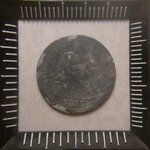
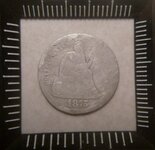
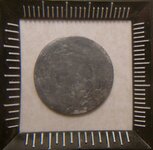
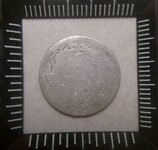
Cheers,
Buck
I don't understand why folks take baking soda and rub it into their blackened silver coins, removing metal, and destroying them for future generations of people who will inherit them. I also don't understand why folks buy expensive silver polishes, cleaners, or dips for anything silver, including flatware or fine dining silver. You don't need it. All you need is hot water, baking soda, and aluminum foil. Here's why:
Polishes, Scrubs, Cleaners, and Dips remove the tarnish from silver, but they also remove a tiny amount of silver as well, along with that tarnish. In the case of "touchless" dips, they remove less good metal, but they still remove some along with the tarnish that they eat away. In the case of polishes, you are removing some good silver through rubbing. Same with a baking soda paste used to "polish" a coin, destroying its value forever. In most cases, you can tell that the coin or object has been cleaned because it is scratched or looks unnatural.
Instead of wasting your money on polishes or dips, take a small glass bowl and line it with aluminum foil, shiny side turned up.
Boil water on the stove or in the microwave
Put a couple tablespoons of baking soda in the bottom of the bowl which was lined with aluminum foil
Drop you silver that you'd like to remove the tarnish from in the bowl on top of the dry baking soda
Fill the bowl with a couple inches of boiling hot water over the item you're cleaning
Wait 2-5 minutes. You should smell a rotten egg smell, or perhaps might see yellow flakes floating on the water. This is sulphur, and it is not dangerous.
Take the coin or item out of the water (careful, it's very hot!) and turn on the tap water in the sink (drain plug in!)
Rub the coin gently between your fingers under running water to remove the tarnish that remains (this is no more destructive than normal circulation wear on coins)
Repeat the above sequence of steps as necessary until the coin no longer bubbles in the baking soda/boiling water solution in the bowl. At that point, it's done all it can do.
The secret to this is that this is the ONLY cleaning method for silver coins (AND beach-dug silver of any sort!) which does not remove good metal as well as tarnish. This method actually turns the tarnish BACK INTO SILVER! Here is a website which details the chemical reaction taking place:
Remove Tarnish from Silver
And here is an 1875 Seated Dime I dug the other day. Before/After photos. Please feel free to post your own before/after photos on this thread if you try this cleaning method. I'd love to see your results!




Cheers,
Buck
Last edited:







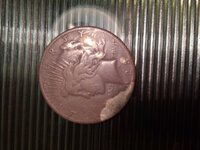
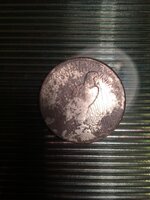
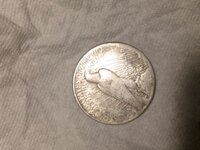
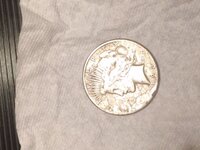
 So easy a caveman can do it!
So easy a caveman can do it!
